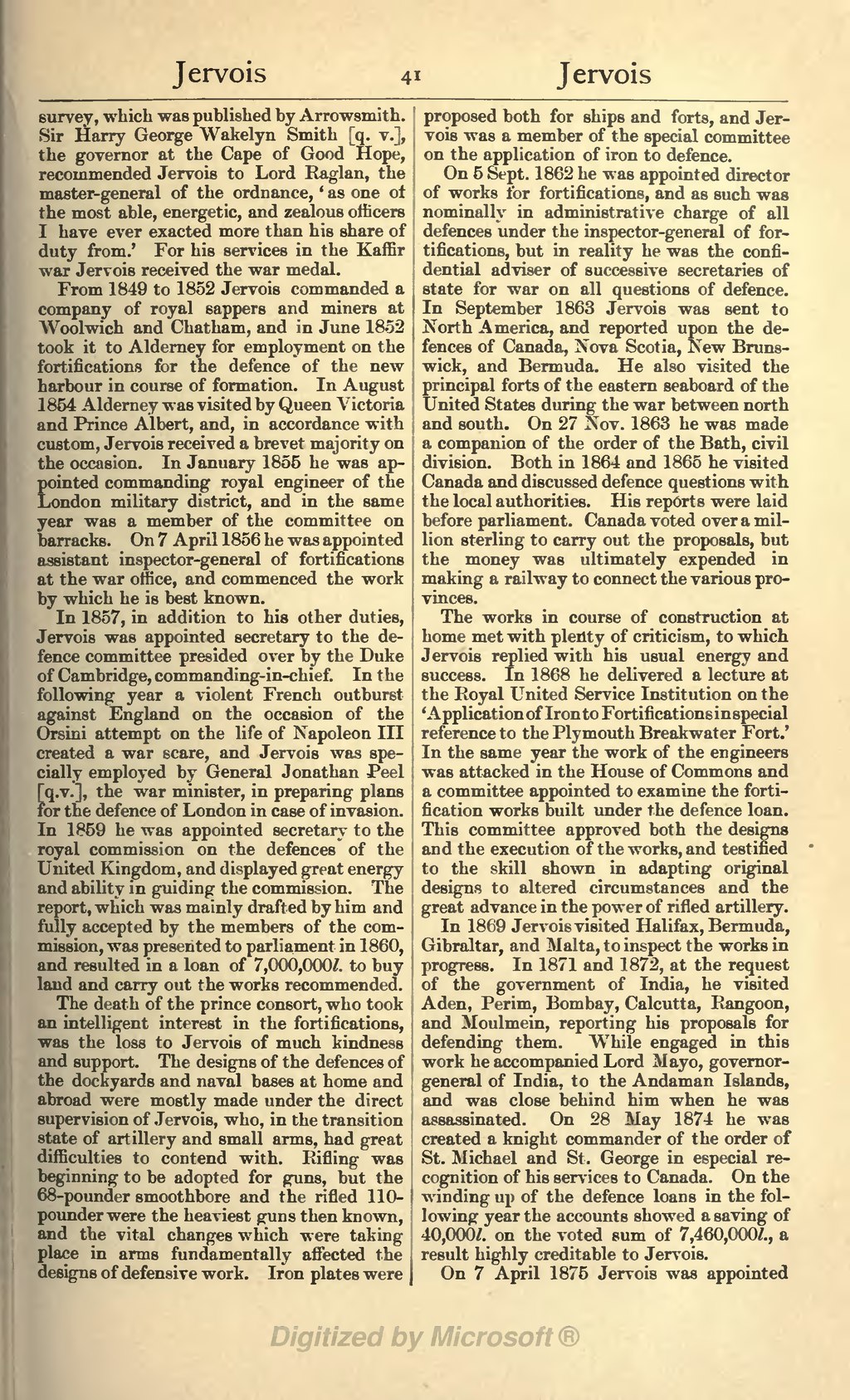survey, which was published by Arrowsmith. Sir Harry George Wakelyn Smith [q. v.], the governor at the Cape of Good Hope, recommended Jervois to Lord Raglan, the master-general of the ordnance, 'as one of the most able, energetic, and zealous officers I have ever exacted more than his share of duty from.' For his services in the Kaffir war Jervois received the war medal.
From 1849 to 1852 Jervois commanded a company of royal sappers and miners at Woolwich and Chatham, and in June 1852 took it to Alderney for employment on the fortifications for the defence of the new harbour in course of formation. In August 1854 Alderney was visited by Queen Victoria and Prince Albert, and, in accordance with custom, Jervois received a brevet majority on the occasion. In January 1855 he was appointed commanding royal engineer of the London military district, and in the same year was a member of the committee on barracks. On 7 April 1856 he was appointed assistant inspector-general of fortifications at the war office, and commenced the work by which he is best known.
In 1857, in addition to his other duties, Jervois was appointed secretary to the defence committee presided over by the Duke of Cambridge, commanding-in-chief. In the following year a violent French outburst against England on the occasion of the Orsini attempt on the life of Napoleon III created a war scare, and Jervois was specially employed by General Jonathan Peel [q. v.], the war minister, in preparing plans for the defence of London in case of invasion. In 1859 he was appointed secretary to the royal commission on the defences of the United Kingdom, and displayed great energy and ability in guiding the commission. The report, which was mainly drafted by him and fully accepted by the members of the commission, was presented to parliament in 1860, and resulted in a loan of 7,000,000l. to buy land and carry out the works recommended.
The death of the prince consort, who took an intelligent interest in the fortifications, was the loss to Jervois of much kindness and support. The designs of the defences of the dockyards and naval bases at home and abroad were mostly made under the direct supervision of Jervois, who, in the transition state of artillery and small arms, had great difficulties to contend with. Rifling was beginning to be adopted for guns, but the 68-pounder smoothbore and the rifled 110-pounder were the heaviest guns then known, and the vital changes which were taking place in arms fundamentally affected the designs of defensive work. Iron plates were proposed both for ships and forts, and Jervois was a member of the special committee on the application of iron to defence.
On 5 Sept. 1862 he was appointed director of works for fortifications, and as such was nominally in administrative charge of all defences under the inspector-general of fortifications, but in reality he was the confidential adviser of successive secretaries of state for war on all questions of defence. In September 1863 Jervois was sent to North America, and reported upon the defences of Canada, Nova Scotia, New Brunswick, and Bermuda. He also visited the principal forts of the eastern seaboard of the United States during the war between north and south. On 27 Nov. 1863 he was made a companion of the order of the Bath, civil division. Both in 1864 and 1865 he visited Canada and discussed defence questions with the local authorities. His reports were laid before parliament. Canada voted over a million sterling to carry out the proposals, but the money was ultimately expended in making a railway to connect the various provinces.
The works in course of construction at home met with plenty of criticism, to which Jervois replied with his usual energy and success. In 1868 he delivered a lecture at the Royal United Service Institution on the 'Application of Iron to Fortifications in special reference to the Plymouth Breakwater Fort.' In the same year the work of the engineers was attacked in the House of Commons and a committee appointed to examine the fortification works built under the defence loan. This committee approved both the designs and the execution of the works, and testified to the skill shown in adapting original designs to altered circumstances and the great advance in the power of rifled artillery.
In 1869 Jervois visited Halifax, Bermuda, Gibraltar, and Malta, to inspect the works in progress. In 1871 and 1872, at the request of the government of India, he visited Aden, Perim, Bombay, Calcutta, Rangoon, and Moulmein, reporting his proposals for defending them. While engaged in this work he accompanied Lord Mayo, governor-general of India, to the Andaman Islands, and was close behind him when he was assassinated. On 28 May 1874 he was created a knight commander of the order of St. Michael and St. George in especial recognition of his services to Canada. On the winding up of the defence loans in the following year the accounts showed a saving of 40,000l. on the voted sum of 7,460,000l., a result highly creditable to Jervois.
On 7 April 1875 Jervois was appointed
